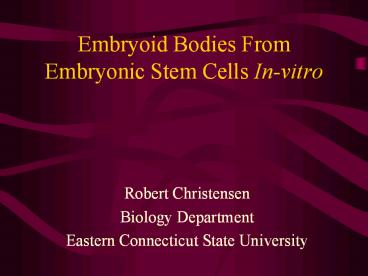Embryoid%20Bodies%20From%20Embryonic%20Stem%20Cells%20In-vitro - PowerPoint PPT Presentation
Title:
Embryoid%20Bodies%20From%20Embryonic%20Stem%20Cells%20In-vitro
Description:
Embryoid Bodies From Embryonic Stem Cells In-vitro Robert Christensen Biology Department Eastern Connecticut State University Endoderm Specific Gene Expression in ... – PowerPoint PPT presentation
Number of Views:136
Avg rating:3.0/5.0
Title: Embryoid%20Bodies%20From%20Embryonic%20Stem%20Cells%20In-vitro
1
Embryoid Bodies From Embryonic Stem Cells In-vitro
- Robert Christensen
- Biology Department
- Eastern Connecticut State University
2
EndodermSpecific Gene Expression in Embryonic
StemCells Differentiated To Embryoid Bodies
- Experimental Cell Research 229 (1999) pp 27-34
Koichiro Abe, Hitoshi Niwa, Katsuro Iwase, Masaki
Takiguchi, Masataka Mori, Shin Ichi Abe, Kuniya
Abe, and Ken- Ichi Yamamura
3
Introduction
- Cell lineages arise during development
- ES cells have full developmental potential
- EBs from ES cells
- Ectodermal tissues
- Mesodermal tissues
- Endodermal tissues
- EBs consist of
- EBs resemble the embryo of the egg- cylinder
stage
- Neuronal cells
- Cardiac muscle cells
- Hematopoietic cells
- Yolk sac cells
- Later stages EBs are composed of
4
- Past studies showed specific changes in
expression of endoderm marker genes
during EB development and suggested that EB
formation could be considered an in-vitro model
for endoderm differentiation.
- This paper extended their analysis and
systematically characterized temporal expression
patterns of endoderm marker genes during EB
formation.
- RNA blot
- Reverse transcription polymerase chain reaction
(RT-PCR) - In-situ hybridization
- The nature of endoderm differentiation in-vitro
is discussed in relation to normal embryonic and
extraembryonic development in-vivo.
5
Materials and Methods
- Cell cultures
- ES cell line, D3, cultured
- Incubated 3 days in Dulbeccos modified eagles
medium (DMEM)
- 15 fetal calf serum
- 0.1 mM 2-mercaptoethanol
- 110 µg/ml sodium pyruvate
- 4.5 mg/ml D-glucose
- Is supplemented with 1000 units/ml recombinant
murine leukemia inhibitory factor (LIF)
6
- LIF was withdrawn
- The cells were allowed to aggregate
- The DMEM was changed every other day throughout
the culture
7
Northern Blot Analysis
- Total RNA prepared from undifferentiated ES
cells, preaggregation ES cells, and EBs of
various stages
- 1 whole dish of EBs was used for isolation of
total RNA
- Samples were collected from undifferentiated ES
cells, preaggregation phase cells, and EBs at
days 0, 1, 2, 3, 4, 5, 7, 9, 11, 13, 15, and 18
- RNA electrophoresed and transferred to Hybond-N
membranes
- Hybridizations performed and signals detected
8
RT-PCR
- Total RNA from various stages, and adult mouse
liver was treated with RNase-free DNase
- cDNA synthesis
- Parallel reaction performed without reverse
transcriptase to assess presence of DNA
contamination
9
Whole-mount in situ hybridization sectioning of
EBs
- These experiments were carried out as described
by Sasaki and Hogan
- Stained EBs were refixed in paraformaldehyde and
glutaraldahyde for 30 minutes
- Then washed twice with PPT and placed in molten
agarose, solidified, then sectioned
10
Molecular Probes
- Xho I fragment of R1 used as ?-fetoprotein (AFP)
probe
- A fragment of Sma I Sac I fragment of pHF22.1
used as a hepatocyte nuclear factor (HNF) probe
- A 660-bp Pst I Pvu II fragment of pmPA1 was
subcloned and used as a transthyretin (TTR) cDNA
probe
- A variant form of HNF1 (vHNF1) probe was
synthesized by PCR using adult mouse liver cDNA
as a template
- Serum albumen (ALB) probe was also made by PCR
11
Results
- vHNF1 and HNF4 transcript levels were very low in
the undifferentiated, preaggregation and day 0
EBs, then abruptly incresed at day 1
- HNF3? began weak, but the expression level
increased after day 1
- TTR expression was still low at day 1, but
increased rapidly thereafter
- These results demonstrate that the activation of
vHNF1, and HNF4 or HNF3? preceded the rise in TTR
expression, beginning at day 1
- At day 1, ES cells formed small compact cell
aggregates, lacking morphologically distinct cell
populations
- Elevation of TTR levels around day 3 coincide
with the appearance of primitive endodermal cells
12
These data show that all the serum protein genes
were activated at different stages, followed by a
strong increase in expression, and all the
transcription factor genes were not active in the
undifferentiated stem cells, and began to be
expressed in early phase differentiation.
13
- The results of the northern blot and RT-PCR
analyses demonstrated that endodermal cell
differentiation occurred during the EB development
- Two types of populations were expressed by day 5
- Yolk-sac-like structures
- Hematopoietic cells
- The TTR messages were found only in the
population of the EBs which began to form
yolk-sac-like structures and were only found in
the outer endodermal layer of the yolk-sac-like
structures
14
This suggests that at least one of the endoderm
marker genes is predominantly expressed in the
outer layer of the yolk-sac-like structure during
EB development
15
The order of gene expression for the in vivo
studies is similar to that found in EB formation
in vitro
16
Conclusion
- These data as a whole strongly suggest that
development of EBs in vitro closely resembles the
sequence of in vivo (normal) development of
visceral yolk sac endoderm.
- The ES cell in vitro differentiation system
should be useful for analyzing molecular events
concerning both extraembryonic and embryonic
endoderm differentiation processes
17
The End































